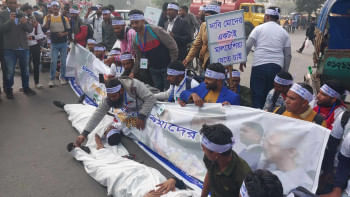Apparel industry needs a clearer strategy for donor funding

Inter-national donors have played a key role in the development of the Bangladesh economy in recent years. Many global donors have huge purse strings and are often able to fund projects that otherwise might not get off the ground. In other cases, they can provide funding for ongoing sustainability work in supply chains where, for instance, suppliers might have difficulty in accessing finance due to the long-term return on investment (ROI) on the project.
In most cases, donor programmes involve a range of actors and might see the donor body itself, brands or retailers, local government representation, suppliers and other local entities working in tandem on a particular project.
While grants and other funding are much welcomed in Bangladesh, the question is, could such money be used better? Could it be better targeted and could project work be better coordinated to lead to improved and more efficient outcomes in Bangladesh? Could and should we be doing things differently to maximise return on donor investment?
These questions are more relevant than ever at the present time, given the serious financial impact the pandemic has had on the Bangladesh economy. In short, we must ensure that every cent that comes into Bangladesh punches its weight and has an impact.
At present, where donor aid in Bangladesh is concerned, the picture is fragmented. There are many projects being implemented by numerous different donors. Drawing up the complete picture of who is doing what would be a difficult challenge because there is such a diverse programme of work taking place at any one time.
While it is good that Bangladesh has been so successful in attracting funding, one of the challenges this brings is duplication due to a lack of coordination. There are similarities among many of the projects being implemented and, in some cases, an overlap of the work of the same donors.
This lack of overall coordination brings a number of issues. Firstly, it leads to a situation where there is an abundance of financial support for some issues but not enough support for others.
It has been recognised for years that there is an urgent need for more support in areas such as social compliance, negotiation skills, workers' mental and physical health, and resource efficiency. How can we better coordinate funding streams to direct resources to areas such as these?
Another factor here is that when multiple projects are being run on the same or similar issues by different organisations, we do not get a proper cost-benefit analysis of each project. Who is measuring the impact of this work and how can we differentiate the impacts of each project from one another? Nobody wants to see money being wasted or used inefficiently, and it is in all our interests to ensure there is a return on donor investment. I think we would all accept that some donor projects have more impact than others and we need to begin asking why this is the case and learn lessons.
A few examples of why projects do not achieve intended consequences include their lack of scale (e.g. focused on just a tiny batch of factories); there is no plan to consider how the work will continue after the donor has pulled its support; donors are often only interested in pilot schemes of two to three years (and factories do not want to contribute financially thereafter); there are no clear key performance indicators (KPIs) or, in many cases, the KPIs are focused on, for instance, numbers of people trained rather than actual impacts; and finally, a lack of collaboration between various stakeholders and agencies involved.
Another factor I have noticed, which could hinder the impact of donors, is when the project work is led by the donor and based on their priorities. While this approach is understandable, could we perhaps see more involvement from owners, managers, local unions and other local stakeholders in outlining the issues we need to address? If local stakeholders do not fully "buy in" to the work identified by the donor, their interest will soon wane and there is a danger that donor money will be squandered.
One more issue which can cause a problem, in my experience, is the lack of sectoral expertise in donor teams. Again, this emphasises the need to use and lean on local expertise to clearly outline where resources need targeting.
Although the Ministry of Planning is the in-charge of planning and projects for the whole country, taking into consideration the importance of the apparel industry to the economy of the country as well as donor's interest in the development of this sector, a special coordination cell or unit could be established within the Ministry of Commerce for only the projects related to this industry. Any proposed projects in the Bangladesh RMG sector would go via this cell, which could coordinate all donor inputs to Bangladesh.
By having a "gate-keeper" such as this, we would be able to ensure that projects are not being duplicated. The cell could use a digital database which, as well as coordinating, could flag necessary areas' action and identify potential donor partners to support us in tackling them.
However, to ensure the transparency and accountability of the cell itself, an advisory council could be formed. The advisory council could potentially be made up of industry experts, representatives from the embassies of the major fund-giving countries and representatives from trade bodies like BGMEA, BKMEA and BTMA. The council could then sit with the cell on a regular basis and identify the hotspots where funding is needed, as well as carry out regular reviews to evaluate the impact of ongoing projects.
Bangladesh is hugely privileged and grateful to receive financial support from the international community—from donors and development partners. It is up to us to ensure we spend the money of our partners wisely.
Mostafiz Uddin is the Managing Director of Denim Expert Limited. He is also the Founder and CEO of Bangladesh Apparel Exchange (BAE) and Bangladesh Denim Expo.


 For all latest news, follow The Daily Star's Google News channel.
For all latest news, follow The Daily Star's Google News channel. 



Comments